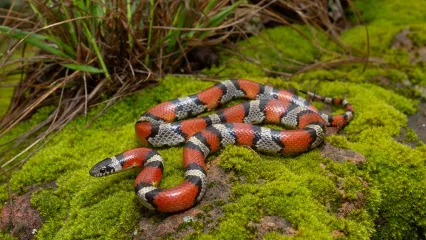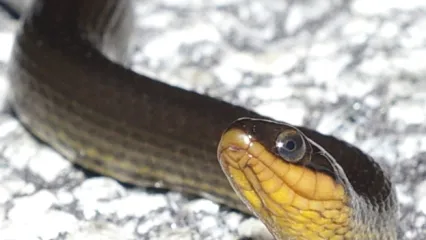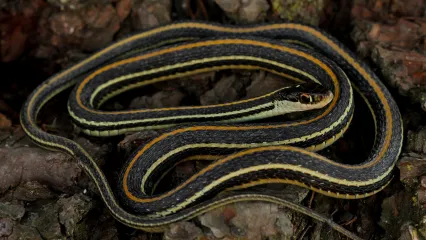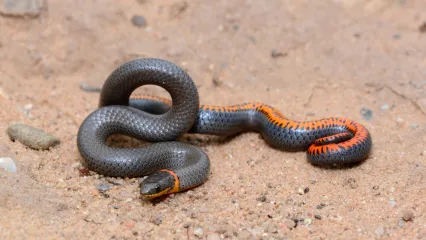
Description
Milksnakes are one of only two species in Oklahoma that have black, white, and red banding. The other is the northern scarletsnake, which is known from central to east-central Oklahoma. The banding in the milksnake consists of wide red bands separated by triads of narrow black-white-black bands. The red bands extend on the sides of the body reaching the ventral scutes at mid-boy. The head is usually black or nearly black but the black coloration is often washed out resulting in lighter coloration on the head, especially in large adults. Milksnakes can be easily distinguished from northern scarletsnakes by a combination of scale and color characteristics. Northern scarletsnakes have a slightly turned up nose resulting from an enlarged rostral scale. The head of northern scarletsnakes is red with the first white band just behind the eye. Red “bands” extend only partially down the lateral surfaces of the body such that they are red blotches rather than bands. Moreover, the black-white-black triads do not form complete bands on the dorsal surface as in milksnakes and the white markings are wider than those in milksnakes.
Size
Large adult milksnakes can reach just over 30 inches in total length although most individuals in the field are about 24 inches in total length.
Habitat
The milksnake complex can be found in eastern Oklahoma, areas of southwestern Oklahoma and in part of the Oklahoma Panhandle.
Life Cycle
Milksnakes are secretive and spend most of their time under surface objects, in crevices, or underground. Although they are generally thought of as living in relatively undisturbed forest habitats, they are also found in valleys that are not cultivated. The activity season is long, extending from March through October. The diet of milksnakes includes lizards, snakes and small mammals, but they appear to prefer skinks. Mating occurs in spring, and females deposit from three to nine eggs. The number of eggs produced by individual females varies with body size. Hatchlings appear in late August and early September.
How To Observe
Milksnakes can be difficult to observe in the field. They are nocturnally active in spring, summer and fall, and can occasionally be found at night crossing roads. During spring and fall they can be found by turning rocks exposed to direct sunlight, and often, they are among the most common snakes found by turning rocks.
(This profile was created by Dr. Laurie Vitt as part of a partnership between the Wildlife Department and the Sam Noble Oklahoma Museum of Natural History. It was funded as part of a larger grant to survey and inventory amphibians and reptiles of the Wildlife Management Areas of Oklahoma: T-35-P-1.)


